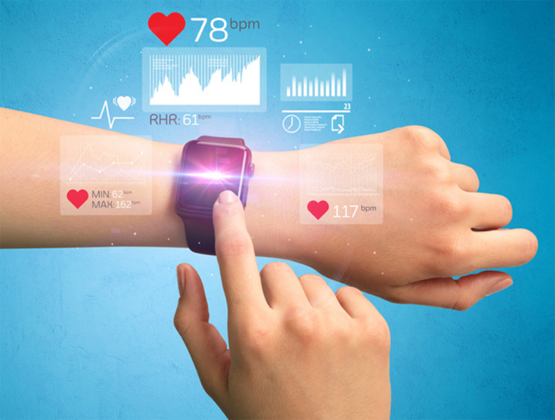Wearable Medical Devices: Challenges and Self-Aware Solutions
By Nima Taherinejad

The number of wearable health-care systems is proliferating exponentially, however, they still face several systematic challenges. Some of these challenges include the battery life-time, the accuracy of these devices, the adversities coming with the movement of the subjects and the vast variations in the environment in which these devices should perform. Design engineers work on these challenges by trying to increase battery lifetime, fabricating more accurate sensors, and designing better signal processing algorithms. However, some of these improvements are rather slow (e.g., battery life-time increase) and some of them are in contradictions with one another (e.g., more complex processing algorithms against the battery life-time). This calls for different type of solutions.
The battery life-time of smart watches, for example, ranges from a couple of days to a month. To extract that many hours of operation from the battery, the number of sensors and features on these watches are in many cases reduced to a minimum.
Continuous monitoring or full usage of all available features brings the battery life-time towards the lower end of the spectrum. For insulin pumps the battery life-time is between 7-14 days for external batteries and 2-6 years for implants. Defibrillators have a similar life time too, about 7 years. To achieve such lifetimes, processing, intelligence, and safety are minimized on these devices and security features are practically non-existent. Furthermore, given the cost and difficulties of surgeries required to change implants, any life-time below current life expectancy for the patients is only sub-optimal.
To have a deeper look at the challenges that wearable medical devices face, let us consider smart watches which are very popular and promising in the future of health monitoring. On one hand, due to issues such as cost, power consumption, and space, they all have a very limited number of sensors (often only a Photoplethysmography (PPG) and accelerometer) and even those sensors have limited accuracy and operation modes again due to restrictions on cost and power consumption. On the other hand, they have to operate under a wide range of environmental changes. The quality of signals captured by their sensors while sitting still or sleeping is quite different compared to those of intense sport activities. The electronic chips – especially those fabricated for such commercial devices- are often designed for room temperature and their performance in hot Hawaiian weather is not the same as in the cold Alpine slopes. A user might be swimming in Mediterranean Sea one day and taking a safari trip in Sahara Desert another day. To make things even more difficult, a number of features such as respiratory rate, sleep pattern, user activity types, and burnt calories are inferred only indirectly from the PPG and acceleration sensors. Despite all these difficulties, it is expected that these device work properly, consistently, and reliably at all times.
To establish and maintain such balanced and delicate operations, these devices need to make many decisions. For example, is the heart rate of 120 beat per minute (BPM) dangerous or not? Should the device notify care givers or health-care personnel? Or at what battery level should the device turn off a certain functionality? Most often the answer to these questions heavily depends on the context. Is 120 BPM a correctly calculated value? Is the sensor and/or inference algorithm functioning properly? Is the user sitting still or in motion? Is turning off a certain functionality going to considerably affect the reliability of the operations of the system and achievement of its goals? Is it expected that the device will be connected to a charger soon? If a wearable healthcare system is going to make all these intricate decisions, it needs to have a good awareness about itself and its environment. Understand the context and its shortcomings, and adjust its operations to compensate for these shortcomings. That motivates research on self-awareness and development of selfaware systems.
Self-awareness of systems refers to the ability of systems to monitor themselves, their resources, their own behavior and that of their environment, and subsequently use this awareness to make decisions which brings them closer to their goals and objectives (which themselves may be changing from time to time). It is important to notice that despite the similarity between self-aware systems and some more traditional systems, the design methodology is different and self-awareness concepts must be considered at design time to achieve good results.
Recently, computational selfawareness methods have been used in some wearable health-care systems and shown a great promise in handling those challenges. In my tutorial at the 2018 IEEE Life Science Conference in Montreal, Canada, I presented the fundamental concepts of self-awareness, with a focus on the elements of observation [1]. Using examples, I showed how each component can help in designing a better system, in particular for wearable health-care. Among examples, we discussed in depth the works I and my colleagues at TU Wien and University of Turku have done on early warning score (currently assessed manually in hospitals and emergency units to predict potential deteriorations in the health of patients) [2-4]. We showed that using concepts such as data reliability, self-aware abstraction, disambiguation, desirability, and attention this score can be assessed using wearables more reliably and accurately, while reducing the power consumption or the need for redundant or very accurate sensors. Using self-aware epileptic seizure detection example [5] of Embedded System Laboratory of EPFL, we discussed how confidence assessment can help to improve the quality of prediction in machine learning algorithms, while reducing its power consumption and required resources.
These examples scratch only the surface of what can be done using computational self-awareness concepts. This leaves a large territory of potentials unexplored, which means considerable opportunities for research and development in this field. To find out what the top researchers in the field of computational self-awareness are doing, I invite you to attend the fourth edition of self-aware cyber-physical systems (SelPhyS) workshop, which this year will be held in Munich, Germany. I am very excited to discover what the future has in store for us, and I hope you are too.
References:
- N. Taherinejad, A. Jantsch, D. Pollreisz, “Comprehensive Observation and its Role in SelfAwareness; An Emotion Recognition System Example”, Position Papers at the 2016 The Federated Conference on Computer Science and Information Systems (FedCSIS) (IWCPS’16), Vol. 9, pp. 117-124, 2016.
- M. Götzinger, N. Taherinejad, A. Rahmani, P. Liljeberg, A. Jantsch, H. Tenhunen, “Enhancing the Early Warning Score System Using Data Confidence,” 6th EAI International Conference on Wireless Mobile Communication and Healthcare (MobiHealth), pp. 91- 99, 2016.
- A. Anzanpour, I. Azimi, M. Götzinger, A. M. Rahmani, N. Taheinejad, P. Liljeberg, A. Jantsch, N. Dutt, “SelfAwareness in Remote Health Monitoring Systems using Wearable Electronics”, Design, Automation and Test in Europe (DATE), pp. 1056-1061, 2017.
- M. Götzinger, A. Anzanpour, I. Azimi, N. Taheinejad, A. M. Rahmani, “Enhancing the Self-Aware Early Warning Score System through Fuzzified Data Reliability Assessment”, 7th EAI International Conference on Wireless Mobile Communication and Healthcare (MobiHealth), pp. 3-11, 2017.
- F. Forooghifar, A. Aminifar, D. Atienza, “Self-Aware Wearable Systems in Epileptic Seizure Detection”, Euromicro Conference on Digital System Design (DSD), Prague, Czech Republic, August 29-31, 2018.
 Nima Taherinejad
Nima Taherinejad
Institute of Computer Technology
TU Wien, Austria






